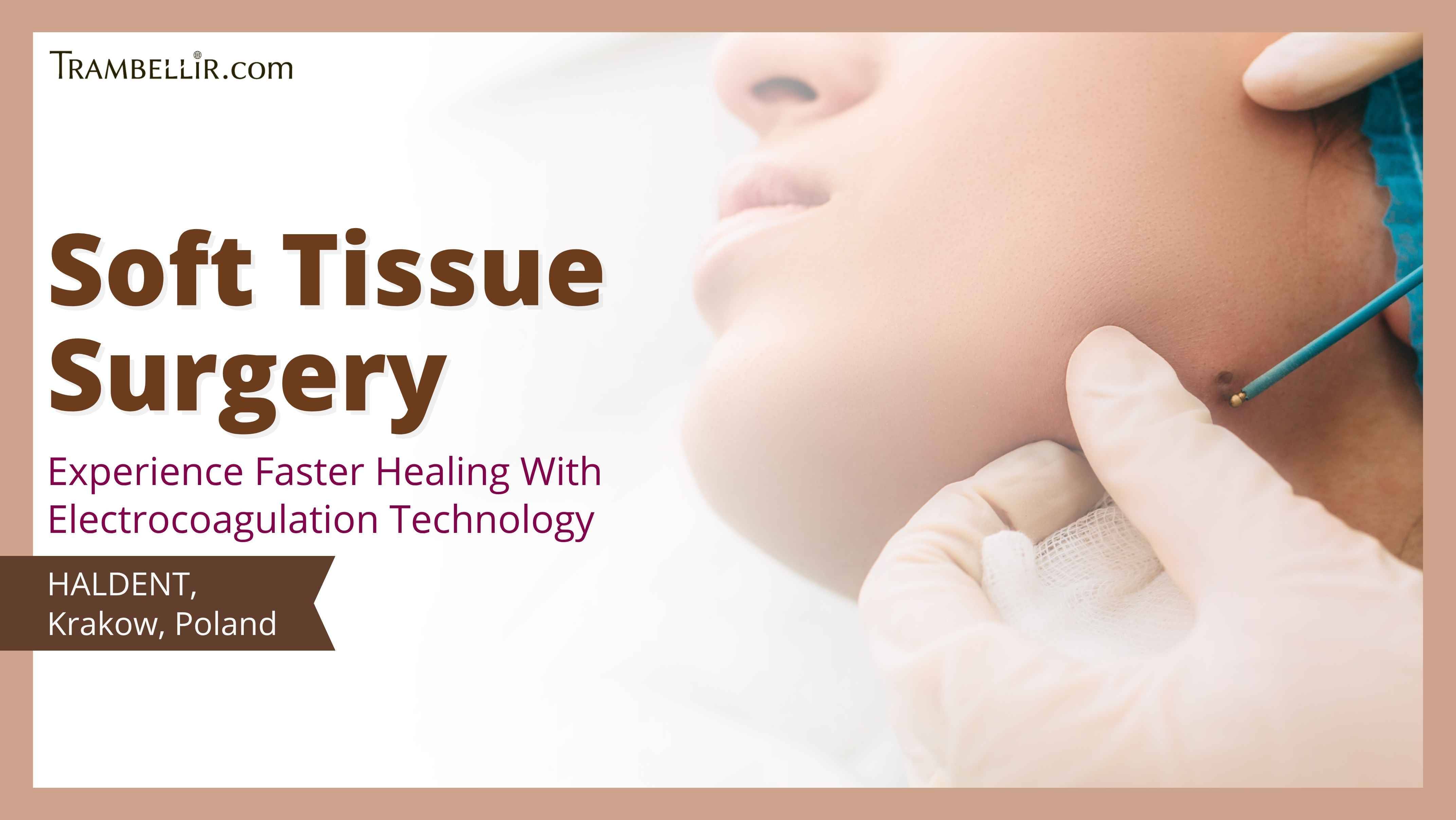It Is Suitable For
· Those in Krakow looking to remove abnormal soft tissue lesions.
· Those who want to reduce bleeding in soft tissue during surgery.
· Those who want to treat soft tissue tumours or growths.
· Those who wish to treat superficial skin conditions.
· Those who wish to use a versatile surgical technique.
What Is Soft Tissue Surgery?
Soft Tissue Surgery using electrocoagulation is a medical technique that involves the use of high-frequency electric current to treat or remove abnormal tissue. When the current passes through the soft tissue via an electrode, it generates heat due to the tissue's natural resistance. This heat can be used to destroy unwanted tissue – such as tumours, lesions, or skin growths – or to seal blood vessels and stop bleeding during surgical procedures.
This method allows for precise targeting of abnormal tissue while minimizing damage to surrounding healthy areas. Soft tissue electrocoagulation is commonly used for conditions like skin cancers, pyogenic granulomas, and other soft tissue abnormalities. Its precision, efficiency, and versatility make it a valuable tool in both minor and more complex soft tissue procedures.
How It Works
Soft Tissue Surgery using electrocoagulation involves the use of an electrosurgical unit (ESU), which produces a high-frequency alternating current. This current is delivered to the tissue through a metal electrode. As the current passes into the soft tissue, the tissue's resistance to electricity generates heat.
Depending on the technique used, the electrode may be applied in different ways. In electrodesiccation, the electrode is placed directly on the tissue surface, causing it to dry out and break down. In electrofulguration, the electrode is held slightly above the tissue, creating a spark that destroys the superficial layer without direct contact. In electrocoagulation, the electrode is pressed against the tissue using a lower voltage and higher current to produce deeper coagulation and tissue destruction. Each method is selected based on the specific surgical requirement and the nature of the soft tissue being treated.
Soft Tissue Surgery Procedure
1. Consultation and examination will be conducted.
2. Local anesthesia will be administered.
3. The electrode will be applied to the targeted soft tissue.
4. High-frequency current will pass through the electrode.
5. Bleeding will be controlled as blood vessels are sealed by the heat.
6. The treated area will be cleaned.
7. Sutures may be placed if necessary.
8. Post-care instructions will be provided.
Advantages and Limitations of Soft Tissue Surgery
<Advantages>
· Provides effective hematosis
· Improves surgical field
· Allows precise tissue destruction
· Targets both superficial and deep soft tissue
· Causes less mechanical trauma than scalpels
· Reduces postoperative pain
<Limitations>
· Not suitable for all tissue types or very large lesions requiring excision
· Healing time may be slower than traditional procedure
Soft Tissue Surgery Preparation
· Fasting may be required for at least 8 hours before procedure
· Refrain from smoking and consuming alcohol for at least 48 to 72 hours before procedure
· Avoid tanning, chemical peels, and laser treatments for at least 2 to 4 weeks before procedure
Soft Tissue Surgery Post Care
· Avoid picking or scratching the treated area
· Avoid excessive sun exposure for at least 4 to 6 weeks after procedure
· Avoid long bath for at least 1 week after procedure
FAQ
Q1: How long does Soft Tissue Surgery take to heal?
A1: Healing time typically ranges from 1 to 3 weeks, depending on the size and depth of the treated tissue. Proper post-care can help speed recovery.
Q2: How painful is electrocoagulation?
A2: The procedure is usually performed under local anesthesia, so pain during the surgery is minimal. Mild discomfort or soreness may occur afterward but generally subsides within a few days.
Q3: Does Soft Tissue Surgery leave scars?
A3: Some scarring may occur, especially if deeper tissue is treated, but careful technique and proper aftercare usually minimize visible scars.
Q4: Can I shower after Soft Tissue Surgery?
A4: You can usually shower 24 to 48 hours after the procedure, but avoid soaking the treated area. Keep the site clean and follow doctor’s instructions on wound care.
Q5: What can electrocoagulation remove?
A5: Electrocoagulation can remove abnormal soft tissue such as skin lesions, tumours, pyogenic granulomas, and other unwanted growths on soft tissues.
Clinic Information
[Clinic Name] HALDENT
[Location] Krakow, Poland
[Nearest Station/ Nearest Tourist Destination] 15mins away from Balice Airport and short distance from most of the tourist attractions
[Clinic Opening Time] Monday to Friday (9:00AM - 8:00PM)
| Operation Time |
2 - 4 hrs |
| Recovery Time |
1 - 3 weeks |
| Number of Postoperative Visit |
Not required |
| Hospitalization |
Not required |
| Limitations |
Pain, swelling, bleeding, infection, scarring, and skin changes may occur |
| Cancellation Policy |
Cancellation is applicable at least 24 hrs in advance |
| Location |
Rodziny Poganów 106c, 32-080 Zabierzów, Poland |
Terms of Service
Trambellir is a health tourism platform and does not in any way provide, promote, or sell any
medication or medical treatment to the Customers.
Customers are advised to contact the healthcare providers directly for any enquiries related to
medical treatments.




